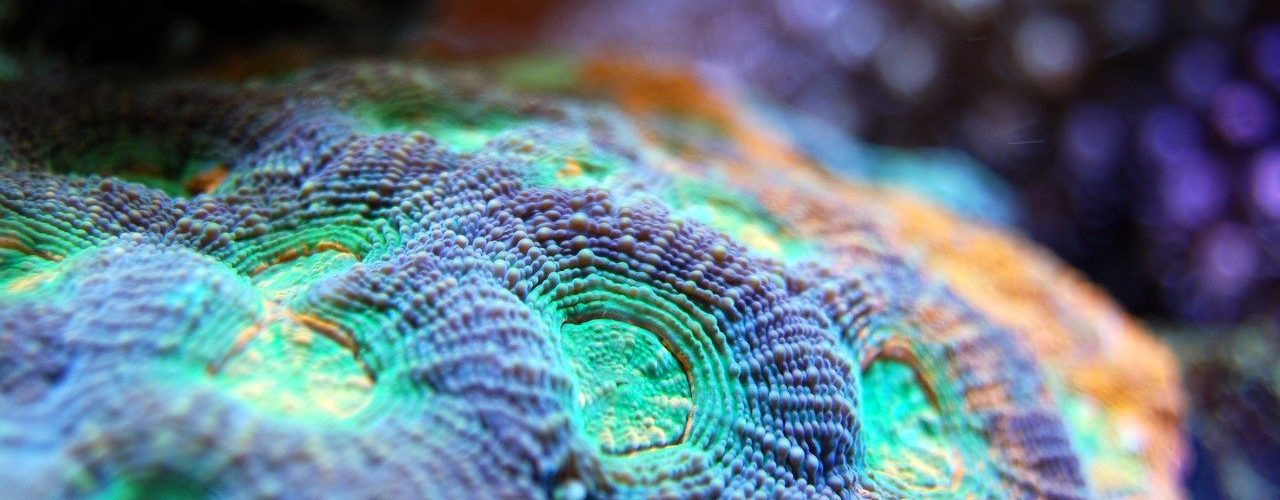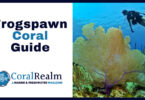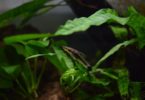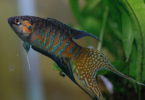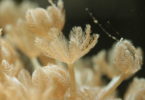Last Updated on November 19, 2022 by Matt
Acan Coral is the common name used for coral species in the genus Acanthastrea. They are one of the most commonly kept and well-known Large Polyp Stony Corals (LPS corals) in saltwater tank setups.
Acanthastrea corals are members of the family Lobophylliidae. Up until 2009 they were part of the Mussidae family, but were moved as part of a reclassification of Indo-Pacific species.
Acan corals have very large polyps and are very brightly colored, which is why they are so highly prized by aquarists. As stony corals, they aren’t reef builders, but are a brilliant addition to any reef tank. They are fast growing and their large polyps are fascinating to watch.
IN THIS ARTICLE
Introducing Acan Coral
The following table gives a brief overview of Acan Coral and the care that they require. For more detailed information please read on further in the article.
| Acan Coral Summary | |
| Family | Lobophylliidae |
| Care level | Moderate |
| Temperament | Semi-aggressive |
| Lighting | Moderate |
| Color | Depends on color morph; Grey, Brown, Green, Orange, Red |
| Diet | Omnivore |
| Water Flow | Low-Moderate |
| pH levels | 8.1-8.4 |
| Water hardness | 8-12 dKH |
| Temperature range | 72-78°F |
| Specific gravity | 1.023-1.025 |
| Compatibility | Most reef fish |
| Supplements | Calcium, Magnesium, Strontium, Trace Elements |
| Tank set up | Saltwater Reef Tank |
As we have said, the taxonomy of Acan Coral was changed in 2009 to reflect more accurate scientific discoveries.
The taxonomy of Acan Coral is as follows:
- Kingdom: Animalia (The phylum which consists of all eukaryotic animals)
- Phylum: Cnidaria (Contains over 11,000 species of both marine and freshwater aquatic animals).
- Class: Anthozoa (A class of marine invertebrates which includes the sea anemones, stony corals, and soft corals).
- Order: Scleractinia (Commonly known as stony or hard corals. Individual animals are called polyps. Many polyps form a single coral. Polyps have a cylindrical body at the top of which a mouth is fringed with tentacles).
- Family: Lobophylliidae
- Genus: Acanthastrea & Micromussa
- Species: Micromussa lordhowensis (Acanthastrea lordhowensis), Acanthastrea echinata, Acanthastrea brevis, Acanthastrea rotundoflora.
Habitat Requirements
Acan Coral can be used in any sized aquarium. As they are found in the natural world between 0-50 meters deep they will thrive in your saltwater setup. Unless you have a huge tank more than 50m deep!
They prefer low to moderate water movement. This is so there is enough water movement in the tank to disperse food and generate flow through the coral’s tentacles. High water flow will most likely buffet the coral and result in the polyp not opening fully. This will end up with the polyp not extending all of the tentacles which will inhibit food capture.
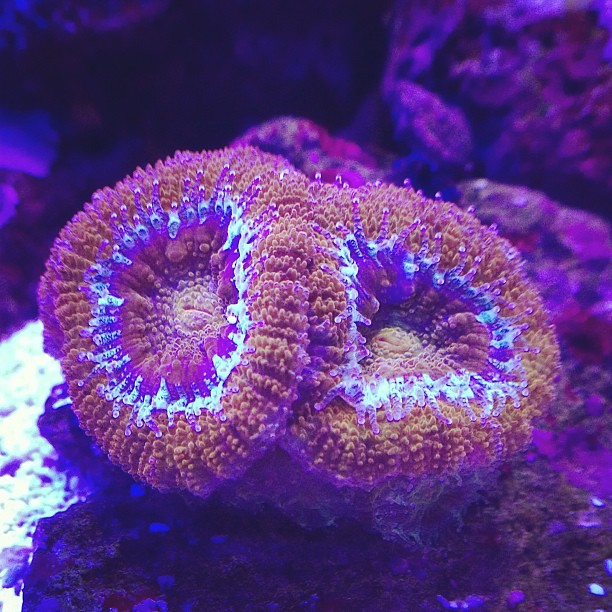
Photo Credit: Aaron Gustafson (Flickr)
Acan Coral like a pH ranging from 8.1-8.4. Ensure that you regularly test the pH level of your reef aquarium, and use an alkalinity buffer if you are seeing variation. The carbonate water hardness needs to be 8-12 dKH. Alkalinity buffers use carbonates to regulate pH, so this will boost the carbonate hardness if it falls as well. Acan coral also needs a temperature range of 72-78°F, and as per most aquarium corals a specific gravity of 1.023-1.025.
They are similar to most aquarium corals, and don’t do badly with added trace elements. Calcium, magnesium, and strontium are elements which are essential supplements for Acan coral.
Acan Coral Feeding

Acan coral, like all tropical corals, are invertebrates which have a symbiotic relationship with dinoflagellate algae called zooxanthellae. Zooxanthellae are primarily single celled dinoflagellates of the family Symbiodiniaceae.
These symbiotic zooxanthellae are photosynthetic and provide the coral with nutrients from this process. However Acan corals are invertebrates in their own right, and so need to feed as well. At night, or during the day in some cases, they extend their polyps, and tentacles to catch passing food and prey.
As such, you need to ensure that your Acan coral gets enough food and nutrients. They will capture passing copepods and brine shrimp. These can be live or frozen, and they will also eat Mysis Shrimp as well. Thinking outside of the box, you can feed them finely chopped seafood. Polyplab Reef-Roids are a brilliant coral food which is perfect for target feeding.
Target feeding Acan coral will ensure that they get the food and nutrients they need for healthy growth and development.
To target feed use a coral feeder such as the PeSandy Coral Feeder to squirt food directly onto the polyps. This enables you to ensure that the coral is getting the food. Just putting food into the tank is a lottery; your fish or other coral may eat it, while it may get removed by the filtration system or protein skimmer.
Target feeding Acan coral about twice a week should be enough for them to get enough food.
Acan Coral Tank Mates
In terms of fish and benthic invertebrates, Acan coral can be kept with most species. Any fish which are reef safe and won’t bite or nibble the polyps will be safe to house with, as the coral won’t be damaged and the fish will be unfazed by the presence of coral.
However Acan coral are quite voracious nocturnal predators, and extend mesenterial filaments to basically get rid of any nearby competition. Any corals, sponges, or other sessile invertebrates within reach will be seriously harmed by these filaments. Therefore care needs to be taken when placing acan corals into an aquarium. They need plenty of space, and if they are placed too close to other coral colonies, other species as well as conspecifics, then they will try and kill them. However you can use this to your advantage by placing Acan corals to keep the growth of fast growing species such as Pulsing Xenia in check.
About 4-6 inches of space between coral colonies should be enough for them to grow without having to fight for dominance.
Some species of coral release toxins into the water column if placed too near to rivals corals. If you are keeping many species of coral in your reef tank just make sure that you have a good filtration system, with a good protein skimmer, and frequent water changes.
Propagating Acan Coral
Propagation, or fragging, of Acan coral isn’t too difficult. While it can be a bit tricky, and it isn’t recommended unless you have previous experience, it can be done without too much issue.
Due to the large size of the coral polyps, it isn’t too hard to cut around the polyp neatly and cleanly. The main issue with fragging corals is getting a nice clean cut around the polyp.
Dieoff after cutting is also common in acan coral after fragging. They can be quite susceptible to bacterial infections that come from being cut. This can be prevented by a quick iodine bath, which helps to clean the wound and stop any nasty bacteria from causing infection.
Check out this video below. It has some great information on acan coral care and maintenance in general, as well as propagation.
Conclusion
Hopefully you have found this acan coral care guide informative and useful! Acans are fantastic corals to have in any reef tank; their bright, bold colors along with their large polyps make them amazing to watch, especially at feeding time! It really is surprising just how much these corals can eat, and how even large chunks of food quickly go down the hatch!
If you think there needs to be anything added please leave a comment below!

